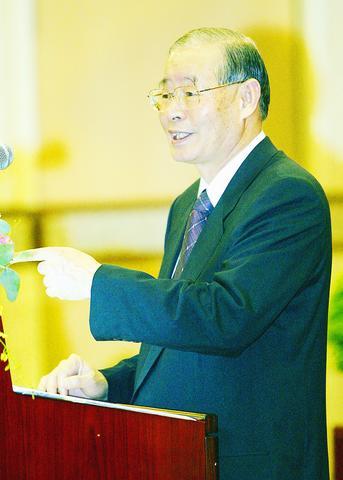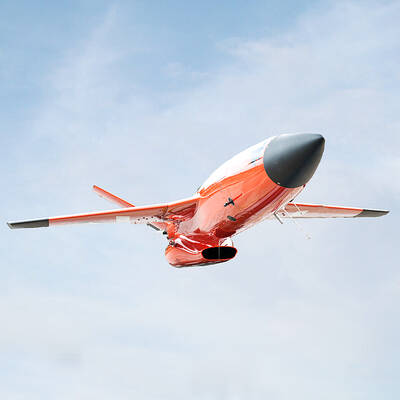The Ministry of National Defense (MND) is to make a budget request in 2005 for the purchase of the US-made Patriot PAC-3 air defense system, defense minister Tang Yao-ming (
The Patriot PAC-3 has been proven to be a reliable system through repeated tests and actual combat experience in the US strike on Iraq in March, Tang said.
Besides the Patriot PAC-3, Tang also announced that the MND has included the purchase plans for a C4ISR (command, control, communication, computer, intelligence, surveillance, and reconnaissance) system and a long-range early warning radar system in the proposed defense budget for 2004.

PHOTO: REUTERS
The C4ISR system is to cost around NT$49 billion, while the long-range early warning radar system around NT$25 billion, reports said. The cost for the Patriot PAC-3 has yet to be set by the US. A quotation for the system is not available until sometime before next August, Tang said.
Tang said the ministry expected to complete a purchase plan for the system by the end of the year.
"But no budget plans could be made for the moment for the purchase. The cost for the PAC-3 will not be known until sometime before next August. So, we will not be able to make our budget request for the purchase of the PAC-3 until 2005," he said.
Tang made the remarks yesterday at a press conference he called for the purpose of paying respect to the press prior to Journalists' Day, Monday.
Arms purchases were the focus of attention. The Patriot PAC-3, diesel-electric submarines, and P-3C anti-submarine warfare aircraft, the major items on the MND's shopping list, were frequently asked about.
"We want to buy the PAC-3 mainly to defend against the ballistic missile threat from China. China is now deploying around 500 ballistic missiles against Taiwan across the strait," Tang said.
"As the PAC-3 is to become part of our missile defense shield, we will not give up our plans to develop a missile defense system on our own," he said.
As to the diesel-electric submarine and P-3C aircraft, the progress of acquisition has not gone well.
"Due to pressure from China, we face a lot of difficulties in the process of looking for a supplier of the submarine. We have not determined what sort of submarine we want since it depends on what we can get," Tang said.
"The P-3C aircraft is not easily available, either. If we want to buy new aircraft of the kind, the cost will be very high since the US has to re-open a production line for these aircraft," he said.
"We are looking for alternative solutions. We do not object to leasing or buying second-hand aircraft." The Patriot PAC-3, the submarine, and P-3C aircraft, because of their high costs, are to be purchased through a special budget that the MND is to ask from the Cabinet
The special budget was initially reported to be made ready next year, but Tang's remarks yesterday suggest the situation is much more complicated than it looks.
The MND might need a special budget of over NT$700 billion, rather than the NT$520 billion so far reported, for the purchase of these three top-of-the-wish-list weapons systems, since the submarine purchase alone would cost at least NT$400 billion according to estimates by the navy.

‘WIN-WIN’: The Philippines, and central and eastern European countries are important potential drone cooperation partners, Minister of Foreign Affairs Lin Chia-lung said Minister of Foreign Affairs Lin Chia-lung (林佳龍) in an interview published yesterday confirmed that there are joint ventures between Taiwan and Poland in the drone industry. Lin made the remark in an exclusive interview with the Chinese-language Liberty Times (the Taipei Times’ sister paper). The government-backed Taiwan Excellence Drone International Business Opportunities Alliance and the Polish Chamber of Unmanned Systems on Wednesday last week signed a memorandum of understanding in Poland to develop a “non-China” supply chain for drones and work together on key technologies. Asked if Taiwan prioritized Poland among central and eastern European countries in drone collaboration, Lin

The Chien Feng IV (勁蜂, Mighty Hornet) loitering munition is on track to enter flight tests next month in connection with potential adoption by Taiwanese and US armed forces, a government source said yesterday. The kamikaze drone, which boasts a range of 1,000km, debuted at the Taipei Aerospace and Defense Technology Exhibition in September, the official said on condition of anonymity. The Chungshan Institute of Science and Technology and US-based Kratos Defense jointly developed the platform by leveraging the engine and airframe of the latter’s MQM-178 Firejet target drone, they said. The uncrewed aerial vehicle is designed to utilize an artificial intelligence computer

Renewed border fighting between Thailand and Cambodia showed no signs of abating yesterday, leaving hundreds of thousands of displaced people in both countries living in strained conditions as more flooded into temporary shelters. Reporters on the Thai side of the border heard sounds of outgoing, indirect fire yesterday. About 400,000 people have been evacuated from affected areas in Thailand and about 700 schools closed while fighting was ongoing in four border provinces, said Thai Rear Admiral Surasant Kongsiri, a spokesman for the military. Cambodia evacuated more than 127,000 villagers and closed hundreds of schools, the Thai Ministry of Defense said. Thailand’s military announced that

CABINET APPROVAL: People seeking assisted reproduction must be assessed to determine whether they would be adequate parents, the planned changes say Proposed amendments to the Assisted Reproduction Act (人工生殖法) advanced yesterday by the Executive Yuan would grant married lesbian couples and single women access to legal assisted reproductive services. The proposed revisions are “based on the fundamental principle of respecting women’s reproductive autonomy,” Cabinet spokesperson Michelle Lee (李慧芝) quoted Vice Premier Cheng Li-chiun (鄭麗君), who presided over a Cabinet meeting earlier yesterday, as saying at the briefing. The draft amendment would be submitted to the legislature for review. The Ministry of Health and Welfare, which proposed the amendments, said that experts on children’s rights, gender equality, law and medicine attended cross-disciplinary meetings, adding that